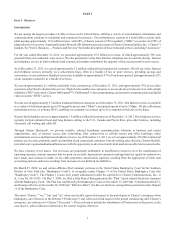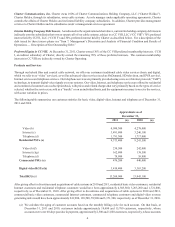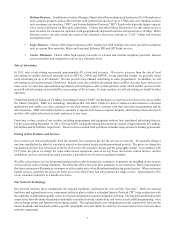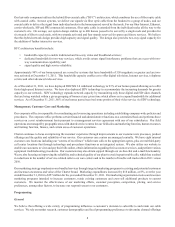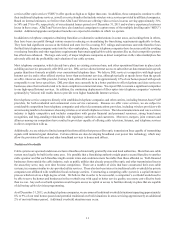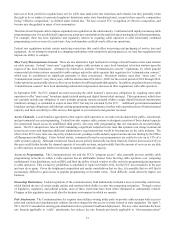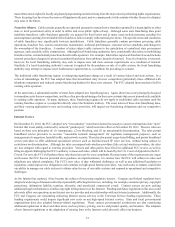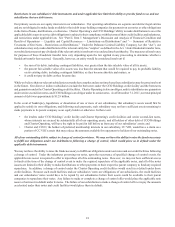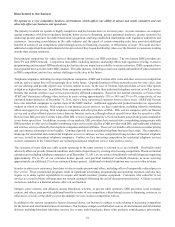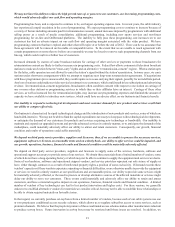Charter 2011 Annual Report Download - page 23
Download and view the complete annual report
Please find page 23 of the 2011 Charter annual report below. You can navigate through the pages in the report by either clicking on the pages listed below, or by using the keyword search tool below to find specific information within the annual report.11
services (fiber optic service (“FiOS”)) offer speeds as high as or higher than ours. In addition, these companies continue to offer
their traditional telephone services, as well as service bundles that include wireless voice services provided by affiliated companies.
Based on internal estimates, we believe that AT&T and Verizon are offering video services in areas serving approximately 31%
to 34% and 3% to 4%, respectively, of our estimated homes passed as of December 31, 2011 and we have experienced customer
losses in these areas. AT&T and Verizon have also launched campaigns to capture more of the multiple dwelling unit (“MDU”)
market. Additional upgrades and product launches are expected in markets in which we operate.
In addition to telephone companies obtaining franchises or alternative authorizations in some areas, and seeking them in others,
they have been successful through various means in reducing or streamlining the franchising requirements applicable to them.
They have had significant success at the federal and state level in securing FCC rulings and numerous statewide franchise laws
that facilitate telephone company entry into the video marketplace. Because telephone companies have been successful in avoiding
or reducing franchise and other regulatory requirements that remain applicable to cable operators like us, their competitive posture
has often been enhanced. The large scale entry of major telephone companies as direct competitors in the video marketplace has
adversely affected the profitability and valuation of our cable systems.
Most telephone companies, which already have plant, an existing customer base, and other operational functions in place (such
as billing and service personnel), offer DSL service. DSL service allows Internet access to subscribers at data transmission speeds
greater than those formerly available over conventional telephone lines. We believe DSL service is competitive with high-speed
Internet service and is often offered at prices lower than our Internet services, although typically at speeds lower than the speeds
we offer. However one DSL provider, Century Link, offers DSL services in approximately 12% of our homes passed with speeds
comparable to our lower speed tiers. DSL providers may currently be in a better position to offer telephone and data services to
businesses since their networks tend to be more complete in commercial areas. We expect DSL to remain a significant competitor
to our high-speed Internet services. In addition, the continuing deployment of fiber optics into telephone companies’ networks
(primarily by Verizon) will enable them to provide even higher bandwidth Internet services.
Our telephone service competes directly with established telephone companies and other carriers, including Internet-based VoIP
providers, for both residential and commercial voice service customers. Because we offer voice services, we are subject to
considerable competition from telephone companies and other telecommunications providers, including wireless providers with
an increasing number of consumers choosing wireless over wired telephone services. The telecommunications and voice services
industry is highly competitive and includes competitors with greater financial and personnel resources, strong brand name
recognition, and long-standing relationships with regulatory authorities and customers. Moreover, mergers, joint ventures and
alliances among our competitors have resulted in providers capable of offering cable television, Internet, and telephone services
in direct competition with us.
Additionally, we are subject to limited competition from utilities that possess fiber optic transmission lines capable of transmitting
signals with minimal signal distortion. Certain utilities are also developing broadband over power line technology, which may
allow the provision of Internet and other broadband services to homes and offices.
Traditional Overbuilds
Cable systems are operated under non-exclusive franchises historically granted by state and local authorities. More than one cable
system may legally be built in the same area. It is possible that a franchising authority might grant a second franchise to another
cable operator and that such franchise might contain terms and conditions more favorable than those afforded us. Well-financed
businesses from outside the cable industry, such as public utilities that already possess fiber optic and other transmission lines in
the areas they serve, may over time become competitors. There are a number of cities that have constructed their own cable
systems, in a manner similar to city-provided utility services. There also has been interest in traditional cable overbuilds by private
companies not affiliated with established local exchange carriers. Constructing a competing cable system is a capital intensive
process which involves a high degree of risk. We believe that in order to be successful, a competitor’s overbuild would need to
be able to serve the homes and businesses in the overbuilt area with equal or better service quality, on a more cost-effective basis
than we can. Any such overbuild operation would require access to capital or access to facilities already in place that are capable
of delivering cable television programming.
As of December 31, 2011, excluding telephone companies, we are aware of traditional overbuild situations impacting approximately
8% to 9% of our total homes passed and potential traditional overbuild situations in areas servicing approximately an additional
2% of our total homes passed. Additional overbuild situations may occur.


